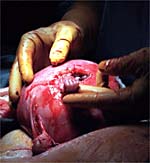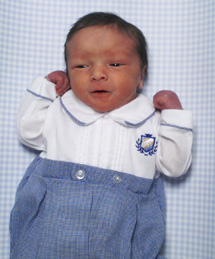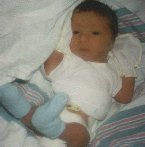Samuel Alexander Armas' Story
The baby is literally hanging on for life. For this is one of the most remarkable photographs taken in medicine and a record of one of the world's most extraordinary operations. It shows a 21-week-old fetus in its mother's womb, about to undergo a spine operation designed to save it from serious brain damage. The surgery was carried out entirely through the tiny slit visible in the wall of the womb and the 'patient' is believed to be the youngest to undergo it. At that age the mother could have chosen to have the fetus aborted. Her decision not to, however, led to an astonishing test not just of medical technology, but of faith. Samuel Armas has spina bifida, which left part of his spinal cord exposed after the backbone failed to develop. The operation was designed to close the gap and protect the cord, the body's motorway for nerve signals to the brain. So, on an unborn patient no bigger than a guinea-pig, the operation was performed without removing the fetus from the womb. The instruments had to be specially designed to work in miniature. The sutures used to close the incisions were less than the thickness of a human hair. An ER-style crash-cart team was on constant standby in an adjoining room. When it was completed, however, Samuel's battle for survival was only just beginning. Nor would the emotional battle his parents had already endured finish quite yet. Julie and Alex Armas had been trying desperately for a baby. Julie, a 27-year-old nurse, had suffered two miscarriages before she became pregnant with the child they intended to call Samuel Alexander if it was a boy. Then, at 14 weeks, she started to suffer terrible cramp. An ultrasound scan was carried out to show the shape of the developing fetus and its position in the womb. When the picture emerged, it was the moment that every parent-to-be dreads. Their unborn son's brain was mis-shapen and his spinal cord was sticking out from a deformed backbone. He had spina bifida. They were devastated and "torn apart'' said Alex, a 28-year-old jet aircraft engineer. At that stage, and even weeks later, the couple could have decided to have the pregnancy terminated. In their home town of Georgia in the US as in Britain abortion is routinely offered. Although accurate figures are not available, many parents accept. For Julie and Alex, who are deeply religious, it was not an option. That didn't mean, of course, that they were not racked by pain at the thought that the child they had longed for was imperfect. It also riddled them with guilt over whether they had effectively taken the decision to inflict their son with years of handicap, pain and suffering. So, this being the United States, they turned to the internet for help. Julie's mother found a website giving details of pioneering surgery being carried out by a team at Vanderbilt University in Nashville, Tennessee. Although the results have not yet been endorsed in medical journals, they looked encouraging to Mr. And Mrs. Armas. Their doctor put them in touch with Dr. Joseph Bruner (it is his finger in the photograph). A race against time had begun. Because it affects the spinal cord, spina bifida can lead to a condition that causes brain damage. Mr and Mrs. Armas were told that if they were to avoid the condition, which was not then present in Samuel, they had to act fast. "I wasn't concerned about a child who couldn't walk,'' said Julie, "but I want a child who knows me.'' The theory behind the surgery is that attention to he spine disorder before the baby is born prevents or limits brain damage, and gives a better chance of healing. It does not cure spina bifida, but it is said to provide a strong chance of limiting the damage through early intervention. The risks, however, are enormous. Controversy surrounds the use of such surgery because it goes against the general medical rule that the risk should not outweigh the benefit. Mr. and Mrs. Armas were fully aware that if anything went wrong, no attempt would be made to deliver Samuel by Caesarean section. Medical science does not yet have the capability to keep a 21-week-old fetus alive outside the womb. The crash-cart was on standby for Julie, not Samuel. "If he dies, that's horrible for me and for us,'' said Julie before she went into theatre. Wiping tears she added: ``But not for him. The worst thing might be if we don't do this, and this is standard treatment when he's 21, and he says: "Why didn't you know about that?'' And we say: ``We did, but we didn't do it for you.'' The other major dangers were turning him in the womb to get his back in line with an inch-long cut in the wall, through which Dr Bruner would operate, and that the surgery might involve releasing the fluid around Samuel. The movement posed the risk of sending Julie into labor contractions, which would have been fatal for Samuel. Thus, one morning at the beginning of last month, Dr Bruner could be heard urging his team to keep quiet. "Shh!'' he said. "You'll wake the baby!'' Robert Davis, who reported on the operation for USA Today newspaper, said the lesion that exposed Samuel's spine was found low on his backbone, decreasing the chance of nerve damage. Although Samuel is believed to have been the youngest patient for such an operation, it was apparently routine enough for Dr Bruner and paediatric neurosurgeon Noel Tullpant to talk about the weather during the operation. An hour later, the womb is gently eased back into place. "Beautiful,'' said one of the technicians and relief swept the room. Julie was allowed home with Alex within days. The baby is due on December 28 [1999]. He has not yet felt the touch of his mother's skin against his own and he knows nothing of life outside her womb. But perhaps Samuel Alexander Armas will be able to shake Dr Bruner's hand again. As reported in Irish Independent newspaper by Paul Harris
UpdateMany people have written asking what happened to Samuel. Happily, both Samuel and his mother are doing well. Below is the letter that Samuel's mother sent out after his birth.
|



